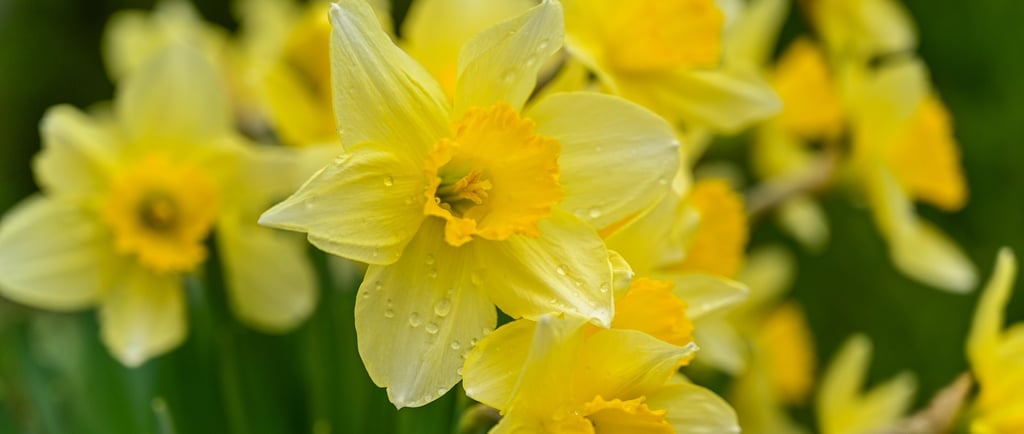The Golden Trumpet 🎺 That Calls Back the Sun 🌼☀️
🌿 A follow-up story from Chapter : The Flower in the Biology Album! 🌼✨ Flowers may look delicate, but they are full of surprises—each with its own strategy for blooming, surviving, and welcoming pollinators! Some flowers burst open in the heat of summer, while others, like the daffodil, arrive before spring has fully awakened. 🌞🌱 Hiding beneath the soil, its bulb patiently stores energy, waiting for the perfect moment to send up its golden trumpet 🎺, announcing the return of the sun! But the daffodil isn’t just a symbol of warmth—it has clever adaptations to survive cold winters, attract sleepy pollinators 🐝, and even protect itself from hungry animals. This story branches from our exploration of floral structures, how petals and colors guide pollinators, and the invisible cycle of renewal hidden beneath the ground. 🌍✨ We wonder together… what other flowers wake up as winter fades? And what secrets do they hold? Let’s take a closer look at the flowers around us and uncover their hidden stories! 🌱💛
BIOLOGY STORIES
2/28/20253 min read


What changes do you notice when the garden wakes up after a long winter? The ground, once hard and cold, softens under the warmth of the sun. Tiny green shoots peek out, as if stretching after a deep sleep. Many plants will soon emerge from their winter nap, one of the first to arrive is this golden trumpet announcing the return of warmth, the daffodil! 🌞🌼 .
But oh, the daffodil has a secret! 🤫 Beneath the soil, hidden from sight, its bulb—a special underground food backpack, different from a root because it holds all the nutrients needed for the plant to grow. His special bulb had been waiting all along, storing energy, preparing for the perfect moment to emerge. This is how it survives the cold winters—by keeping all it needs inside, like a treasure chest buried in the earth. And then, when the world is ready, up it comes, sending out leaves to catch the sun and a flower to shine like a little piece of the sun itself! 🌱✨
Long, long ago, people noticed these golden blooms appearing just as winter was fading, and they thought they must be magical. Even its scientific name👏 Nar 👏 cis 👏 sus 👏 carries a story! 📖✨In ancient Greece, there was a boy named Narcissus who was so mesmerized by his own reflection in a pool of water that he stayed there forever, gazing at himself. The gods, feeling sorry for him, transformed him into a flower that bent its head toward the water—this is why the daffodil’s scientific name is Narcissus!
But this flower is not just part of myths; it plays an important role in the grand web of life. When a daffodil blooms, it is like an invitation to the early pollinators. 🐝 Its bright yellow corolla—the trumpet-shaped center—acts as a landing path, leading bees and other insects straight to the nectar. The shape helps protect the pollen from wind and rain while making it easier for pollinators to collect food. What a clever way to ensure the next generation of daffodils! 🌼🐝
🐝 Sleepy from winter, bees wake up and come searching for food, buzzing excitedly as they discover a sweet surprise! They fly from flower to flower, sipping nectar and carrying pollen, helping new daffodils grow. And have you noticed how daffodils grow in clusters? This happens because each daffodil bulb can produce multiple flowers, and over time, bulbs also create tiny baby bulbs, called offsets, that stay close to the parent plant. They do this to protect each other, standing together against the wind and cold, like a family huddling for warmth. 🌬️🐝
Daffodils have their own way of keeping safe, too! 🛡️ Their bright yellow petals warn animals, “Stay back! I am not for eating!” Inside their leaves and stems is a special juice that makes them taste bitter, keeping hungry creatures like rabbits and deer away. This is how they have survived for thousands of years—by learning to protect themselveswhile still bringing beauty to the world.
And here’s another secret—daffodils follow the light! 🌞 Their flowers turn toward the sun, just like tiny sunseekers. This is called phototropism 👏 Pho 👏 to 👏 tro 👏 pism 👏 (photo, meaning “light,” and tropos, meaning “turning”). They reach for the sun just as we stretch our hands toward warmth after a cold day. ☀️👐
Daffodils remind us of the quiet strength and resilience that plants have. They stand as a symbol of nature’s cycles, patience, and renewal. 🌍✨
🤔Now I wonder… what other flowers will soon wake up from their winter sleep? Would you like to play a game and discover them? Let’s use “Who Am I?” cards to guess different spring flowers and learn their secrets! What mysteries do they hold? 🌱🌸✨
I have here with me some of the Who Am I? cards. Let’s read the first one. Now, let’s look at these photos of flowers and read the text card again for more clues. flower 1, flower 2, flower 3, flower 4.
With Montessori joy,
Vanina 😊

